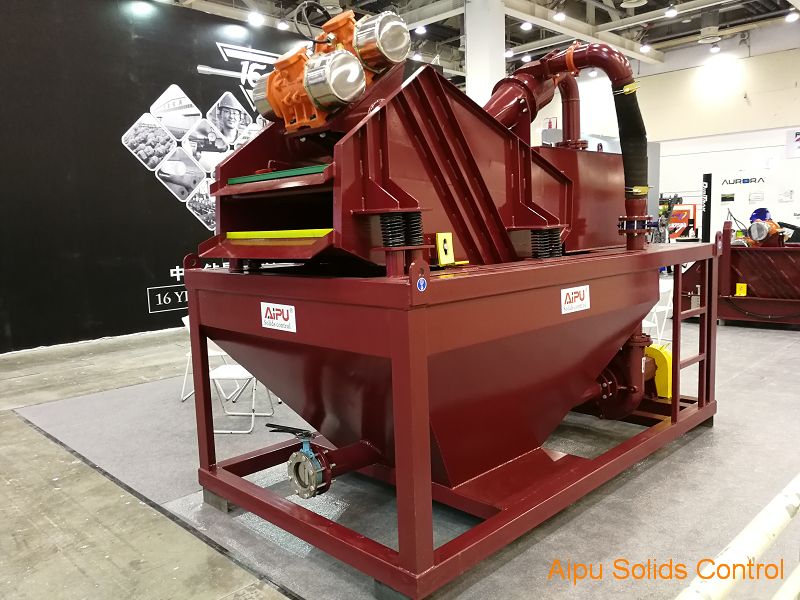Shaanxi Aipu Solids Control Co., Ltd |
|
A mud system, also known as an oil drilling mud system is a control system specially designed for oil gas drilling rigs. The system maintains the solids control and the overall performance of different equipment installed for the drilling fluid. Below we'll main introduce the APMC mud cleaning system.
Desanding Plant is the economic way for mud recycling, it is popular for Bored Pile Slurry desanding plant, TBM slurry treatment, HDD (trenchless) as well as water well drilling, etc.
Model | Capacity | Separation size | The water content of discharge | Power |
APMC50 | 50m³/h | 30μm | <50% | 18KW |
APMC100 | 100m³/h | 30μm | <50% | 22KW |
APMC200 | 200m³/h | 60μm | <50% | 50KW |
APMC250 | 250m³/h | 60μm | <50% | 60KW |
APMC500 | 500m³/h | 60μm | <50% | 145KW |
Such a mud cleaning system is designed for mud purification and recovery of the bored piles, rotary drilling rig, antiseepage engineering, core drilling and etc, which can reduce costs and improve construction efficiency.

The slurry pump sucks the mud from the mud pit then enter into the
bottom layer screen of shale shaker (3) through the buffer box(2),
the coarse particles will be separated out and the mudflow to the
mud storage tank (4) through the bottom layer screen of shale
shaker(3). The centrifugal pump (5) takes mud from the recycling
tank(4), and feeds it to the desander cone (6) with pressure for
centrifugal separation, the solids/sand was discharged to the upper
shaker(3) from the outlet nipple of the desander cone.
After the dewatering process of the upper shaker(3), the fine
solids were separated out. The mud passed the upper shaker screen
returns back to the recycling tank(4), the clean mud entered into
the intermediary tank(7) through a desander cone overflow pipe. The
mud in the intermediary tank (7) will go out through the outlet
pipe (9) or go back to the recycling tank (4) depends on the fluid
level in the recycling tank.
In the mud circulation process, there is a fluids level float
switch (8) between the intermediary tank (7) and the recycling tank
(4), it can balance the fluids level in the recycling tank(4). When
mud level is low in the recycling tank (4) the overflow from the
desander will enter the recycling tank (4) through the intermediary
tank (7). When the mud level is too high in the recycling tank (4),
the mud will overflow to the intermediary tank (7) and go out from
the outlet pipe (9). If operators want to get high-quality clean
fluids, the feeding capacity to the system can be reduced, and the
repeat cleaning process will get the result.
Recycling and reusing drilling fluids is becoming increasingly common on jobs with mid-size horizontal directional drill (HDD) projects where previously that practice was uncommon.
Recycling isn’t for every job – it would not be practical on jobs with small machines making short bores – but contractors who are recycling on larger projects with 30,000 to 60,000-pound pullback equipment are reporting surprising cost savings resulting in overall lower project costs.
Savings come from using less water and drilling additives, less time in mixing fluids, reduced clean-up requirements, and significant reduction in costs of hauling water to make the fluid and dispose of it after a job is complete.
Mud recycling is standard procedure on HDD projects with big drill rigs – to not recycle fluids on a long, deep bore with a big machine using a mud motor would make the logistics of handling fluids unmanageable and cost-prohibitive, and the physical size of recyclers used on these projects would not permit their use on work sites of the mid-size drill rigs that do utility work.
1. Economic configuration
2. Reduce environmental impact
3. Easy operation and maintenance
4. Stable and reliable operation
5. Compact structure and small footprint
Aipu solids control offers a complete range of specialist services,
making use of current technology to provide clients with a range of
competitive
and efficient services.
Aipu solids have involvement in projects both onshore and offshore areas worldwide. Aipu solids equipment to more than 30 countries in the Middle East, Russia, Latin America, North America, Asia, Europe, Africa, and Oceania. Aipu head office is in Xi'an city which is almost the center of China, and convenient to everywhere by land, rail, sea, and air.
All Aipu work is carried out to clients' specifications and
instructions to a standard or code of practice relevant to a
particular contract. Furthermore,
we are API certified company. Please trust, under the talents of
the Aipu team you will get maximum drilling fluid recovery from
solids control and
waste management process, and minimum waste management costs.
So if you want to get a better and more effective solution, please contact us without hesitation.
